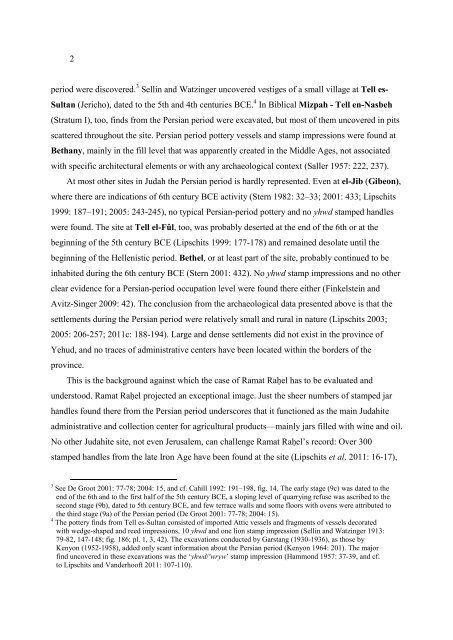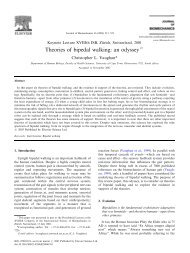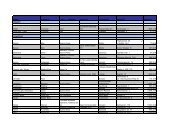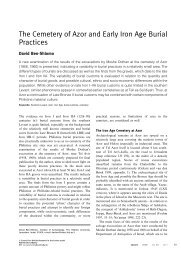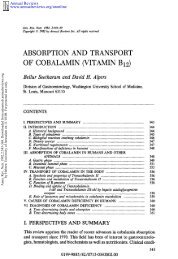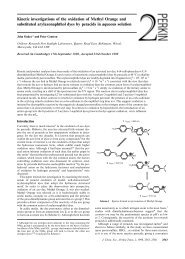The Riddle of Ramat Raḥel: The Archaeology of a Royal Persian ...
The Riddle of Ramat Raḥel: The Archaeology of a Royal Persian ...
The Riddle of Ramat Raḥel: The Archaeology of a Royal Persian ...
Create successful ePaper yourself
Turn your PDF publications into a flip-book with our unique Google optimized e-Paper software.
2period were discovered. 3 Sellin and Watzinger uncovered vestiges <strong>of</strong> a small village at Tell es-Sultan (Jericho), dated to the 5th and 4th centuries BCE. 4 In Biblical Mizpah - Tell en-Nasbeh(Stratum I), too, finds from the <strong>Persian</strong> period were excavated, but most <strong>of</strong> them uncovered in pitsscattered throughout the site. <strong>Persian</strong> period pottery vessels and stamp impressions were found atBethany, mainly in the fill level that was apparently created in the Middle Ages, not associatedwith specific architectural elements or with any archaeological context (Saller 1957: 222, 237).At most other sites in Judah the <strong>Persian</strong> period is hardly represented. Even at el-Jib (Gibeon),where there are indications <strong>of</strong> 6th century BCE activity (Stern 1982: 32–33; 2001: 433; Lipschits1999: 187–191; 2005: 243-245), no typical <strong>Persian</strong>-period pottery and no yhwd stamped handleswere found. <strong>The</strong> site at Tell el-Fûl, too, was probably deserted at the end <strong>of</strong> the 6th or at thebeginning <strong>of</strong> the 5th century BCE (Lipschits 1999: 177-178) and remained desolate until thebeginning <strong>of</strong> the Hellenistic period. Bethel, or at least part <strong>of</strong> the site, probably continued to beinhabited during the 6th century BCE (Stern 2001: 432). No yhwd stamp impressions and no otherclear evidence for a <strong>Persian</strong>-period occupation level were found there either (Finkelstein andAvitz-Singer 2009: 42). <strong>The</strong> conclusion from the archaeological data presented above is that thesettlements during the <strong>Persian</strong> period were relatively small and rural in nature (Lipschits 2003;2005: 206-257; 2011c: 188-194). Large and dense settlements did not exist in the province <strong>of</strong>Yehud, and no traces <strong>of</strong> administrative centers have been located within the borders <strong>of</strong> theprovince.This is the background against which the case <strong>of</strong> <strong>Ramat</strong> <strong>Raḥel</strong> has to be evaluated andunderstood. <strong>Ramat</strong> <strong>Raḥel</strong> projected an exceptional image. Just the sheer numbers <strong>of</strong> stamped jarhandles found there from the <strong>Persian</strong> period underscores that it functioned as the main Judahiteadministrative and collection center for agricultural products—mainly jars filled with wine and oil.No other Judahite site, not even Jerusalem, can challenge <strong>Ramat</strong> <strong>Raḥel</strong>’s record: Over 300stamped handles from the late Iron Age have been found at the site (Lipschits et al. 2011: 16-17),3 See De Groot 2001: 77-78; 2004: 15, and cf. Cahill 1992: 191–198, fig. 14. <strong>The</strong> early stage (9c) was dated to theend <strong>of</strong> the 6th and to the first half <strong>of</strong> the 5th century BCE, a sloping level <strong>of</strong> quarrying refuse was ascribed to thesecond stage (9b), dated to 5th century BCE, and few terrace walls and some floors with ovens were attributed tothe third stage (9a) <strong>of</strong> the <strong>Persian</strong> period (De Groot 2001: 77-78; 2004: 15).4 <strong>The</strong> pottery finds from Tell es-Sultan consisted <strong>of</strong> imported Attic vessels and fragments <strong>of</strong> vessels decoratedwith wedge-shaped and reed impressions, 10 yhwd and one lion stamp impression (Sellin and Watzinger 1913:79-82, 147-148; fig. 186; pl. 1, 3, 42). <strong>The</strong> excavations conducted by Garstang (1930-1936), as those byKenyon (1952-1958), added only scant information about the <strong>Persian</strong> period (Kenyon 1964: 201). <strong>The</strong> majorfind uncovered in these excavations was the ‘yhwd/'wryw’ stamp impression (Hammond 1957: 37-39, and cf.to Lipschits and Vanderho<strong>of</strong>t 2011: 107-110).


